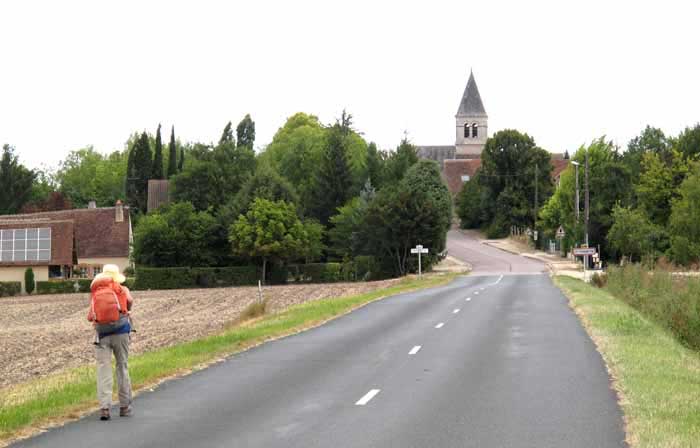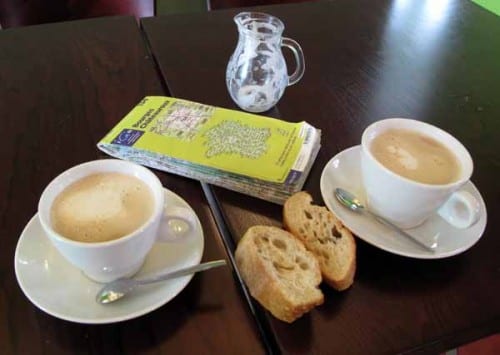
Saturday, 9 July 2011
Distance 16 km
Duration 3 hours 5 minutes
Ascent 60 m, descent 81 m
Map 134 of the TOP100 lime-green series
Anticipating only a short walk to Mehun-sur-Yèvre, we allowed ourselves to sleep in until 7:15. The morning was fine but too windy for comfort, so we took our gear into the laundry of the ablutions block and made breakfast unglamorously on a washing machine.
That done, we crossed the bridge for the last time, turned left at the bar corner and resumed yesterday’s walk on the D35.
Looking back at the compact village in its widespread of fields, we could easily imagine it under snow or driving rain, snug and self-contained.


For a kilometre or so the GR41 came along the road with us, but as soon as we had passed the château it vanished up a lane.
We were not tempted to follow, as we could see on the map that it described a couple of big loops before ending up back on the road a few kilometres further on. In any case, this road was very quiet, the main highway along the Cher being on the other side.
An hour’s stroll through sunflowers and wheat stubble brought us to the village of Sainte-Thorette, like Villeneuve a tiny settlement on one of the roads radiating out from Bourges.

As usual we hoped fervently to find a bar here and indeed there was one, down near the bridge, to which we were directed by a passing woman.
The young barman welcomed us in – he had only just opened the door – and set about preparing our coffee.
I mentioned that a couple of croissants would be nice, at which his wife hurried off in the car to collect some, with the bread order for the restaurant, but came back without any, as it was too late in the morning by then (9:30 am).

Instead we ate the rounds of bread that we had removed from the dinner table last night for just such an eventuality.

Continuing on our peaceful way, we passed through an ocean of sunflowers, with the wind turbines on the hill behind like the skeletons of sailing ships.
The countryside gave way to the suburbs of Mehun-sur-Yèvre as soon as we crossed the autoroute and we still had four kilometres to go to the centre.
This was rather dreary and we thought of taking a detour along the “Chaussée de César”, the old Roman way from Bourges, but it turned out to be an ordinary bitumen road, so we pressed on.
At the railway station we followed the signs to the Office of Tourism, which took us over the Canal de Berry (last seen at St-Amand-Montrond), then up a steep, narrow one-way street lined with ancient houses in various stages of neglect and decay.

Most of the shops seemed to be boarded up, but at the top it was a bit livelier.
We went through a magnificent stone archway with a clock tower – “La Porte de l’Horloge” – in what had been the town wall in mediaeval times, and found the Office of Tourism just beyond it, on the peripheral highway (D2076).
We got maps of Mehun and of Vierzon, our destination for tomorrow, and learned that the camping ground was just along the street.

We found it on the very top of the rise, next to the water tower, exposed to every breath of wind and bare except for a tall double line of trees. The amenities block was sparklingly clean, although not new.
We had lunch, lay down on our mats and fell asleep. It was 3:30 when we came round and set about putting up the tent among the white behemoths that were our neighbours. It looked like a mouse among elephants.
After that we wandered back towards the old town in search of a bar with the Tour de France showing on the TV, but the drinkers of Mehun did not seem interested in their national sport. Nevertheless, we found a pleasant café beside the Tour de l’Horloge, with tables set out under the trees.
A small wedding party walked past on their way to the Mairie, the bride carrying flowers and the guests wearing paper garlands, like a scene out of Madame Bovary.

Refreshed with beer and coffee, we took a turn to the nearby château on its rocky promontory.
All that remains now are a couple of ruined towers, vestiges of the luxurious fourteenth-century pleasure-palace of the Duc de Berry, which was itself a refurbishment of an earlier stronghold from the time when Mehun-sur-Yèvre was on the frontier of the territory held by the French king (early 1200s). This in turn had supplanted a succession of forts on the site, going back into prehistory.
Our next mission was to find somewhere to eat that night. Although it was Saturday, no restaurants seemed to be open, and many looked as if they would never open again.
The advice of the barman at the Café de l’Horloge was to try the Chinese place on the highway above. This turned out to be a good idea.

After an apéritif in the camping ground – the last of the wine that we had bought in St-Florent, sipped daintily from plastic containers – and a chat with some of our neighbours, we presented ourselves at the “Asiatique Pacifique Mandarin”.
Although we normally avoid Asian restaurants while in France (preferring the more convincing Australian version of these cuisines), we thoroughly enjoyed our evening here.

The place was crowded with local families and the meal was in the form of a buffet, at €13.50 per head. As the décor was relentlessly pink, we decided on a jug of rosé instead of the usual red, and refilled our plates several times from the shining vats around the walls.
There were all manner of fried and steamed rolls, a lot of seafood, tofu dishes and various concoctions of vegetables and meat. We kept away from the sickly-looking desserts – we were full by then anyway.
As one family at the adjoining table got up to go, the man smiled at us and said, in English “See you!”. The next man coming past tried his English too – ”Enjoy!” It gave us a delightful feeling of comradeship.
Previous day: Châteauneuf-sur-Cher to Villeneuve-sur-Cher